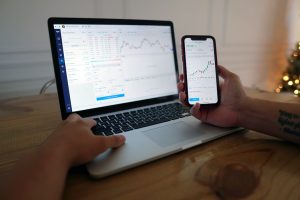Divergence in forex signals occurs when the price of an asset moves in the opposite direction of an indicator or technical analysis tool. This discrepancy between the price movement and the indicator can signal a potential change in the price trend and can be used as a trading signal by forex traders.
Types of Divergence
There are two types of divergence in forex signals: bullish and bearish.
Bullish Divergence: Bullish divergence occurs when the price of an asset is making lower lows, but the indicator or technical analysis tool is making higher lows. This can indicate that the momentum of the price trend is slowing down, and a potential reversal in the trend may occur. Traders may interpret this as a buy signal, as the price may start to increase after hitting the bottom.
Bearish Divergence: Bearish divergence occurs when the price of an asset is making higher highs, but the indicator or technical analysis tool is making lower highs. This can indicate that the momentum of the price trend is slowing down, and a potential reversal in the trend may occur. Traders may interpret this as a sell signal, as the price may start to decrease after hitting the top.
Types of Indicators
There are various indicators or technical analysis tools that traders can use to identify divergence in forex signals, such as:
1. Relative Strength Index (RSI): The RSI is a momentum oscillator that measures the strength of an asset’s price movement. It compares the average gains and losses over a specific period of time to determine whether the asset is overbought or oversold. If the RSI is making higher lows while the price is making lower lows, this can signal bullish divergence. If the RSI is making lower highs while the price is making higher highs, this can signal bearish divergence.
2. Moving Average Convergence Divergence (MACD): The MACD is a trend-following momentum indicator that shows the relationship between two moving averages of an asset’s price. Traders can look for divergences between the MACD and the price of an asset to identify potential trend reversals.
3. Stochastic Oscillator: The Stochastic Oscillator is a momentum indicator that compares the closing price of an asset to its price range over a specific period of time. It can help traders identify overbought and oversold conditions in the market. Traders can look for divergences between the Stochastic Oscillator and the price of an asset to identify potential trend reversals.
How to Trade Divergence
Traders can use divergence in forex signals to enter or exit trades. Here are some steps to follow when trading divergence:
1. Identify the Divergence: Traders need to identify the divergence between the price of an asset and the indicator or technical analysis tool. They can use different indicators to confirm the divergence and increase the probability of a successful trade.
2. Wait for Confirmation: Traders should wait for confirmation of the divergence before entering a trade. This can include waiting for the price to break a trendline or waiting for a candlestick pattern to form.
3. Enter the Trade: Traders can enter the trade once the divergence is confirmed. They can set a stop loss to limit their risk and a take profit level to lock in their profits.
4. Manage the Trade: Traders should manage the trade by monitoring the price action and adjusting their stop loss and take profit levels accordingly. They can also consider adding to their position if the price continues to move in their favor.
Conclusion
Divergence in forex signals can be a powerful tool for traders to identify potential trend reversals and enter or exit trades. Traders need to use different indicators to confirm the divergence and wait for confirmation before entering a trade. They should also manage the trade by monitoring the price action and adjusting their stop loss and take profit levels accordingly.





